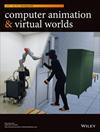Cartoon images play a vital role in film production, scientific and educational animation, video games, and other fields, and are one of the key visual expressions of artistic creation. However, since hand-crafted cartoon images often require a great deal of time and effort on the part of professional artists, it is necessary to be able to automatically transform real-world images into different styles of cartoon images. Although cartoon images vary from artist to artist, cartoon images generally have the unique characteristics of being highly simplified and abstract, with clear edges, smooth color shading, and relatively simple textures. However, existing image cartoonization methods tend to create a number of problems when performing style transfer, which mainly include: (1) the resulting generated images do not have obvious cartoon-style textures; and (2) the generated images are prone to structural confusion, color artifacts, and loss of the original image content. Therefore, it is also a great challenge in the field of image cartoonization to be able to make a good balance between style transfer and content keeping.
In this paper, we propose a GAN-based multi-attention mechanism for image cartoonization to address the above issues. The method combines the residual block used to extract deep network features in the generator with the attention mechanism, and further strengthens the perceptual ability of the generative model to cartoon images through the adaptive feature correction of the attention module to improve the cartoon features of the generated images. At the same time, we also introduce the attention mechanism in the convolution block of the discriminator, which is used to further reduce the image visual quality problem caused by the style transfer process. By introducing the attention mechanism into the generator and discriminator models of the generative adversarial network, our method enables the generated images to have obvious cartoon-style features while effectively improving the image's visual quality.
A large number of quantitative, qualitative, and ablation experiments are conducted to demonstrate the advantages of our method in the field of image cartoonization and the role of each module in the method.


